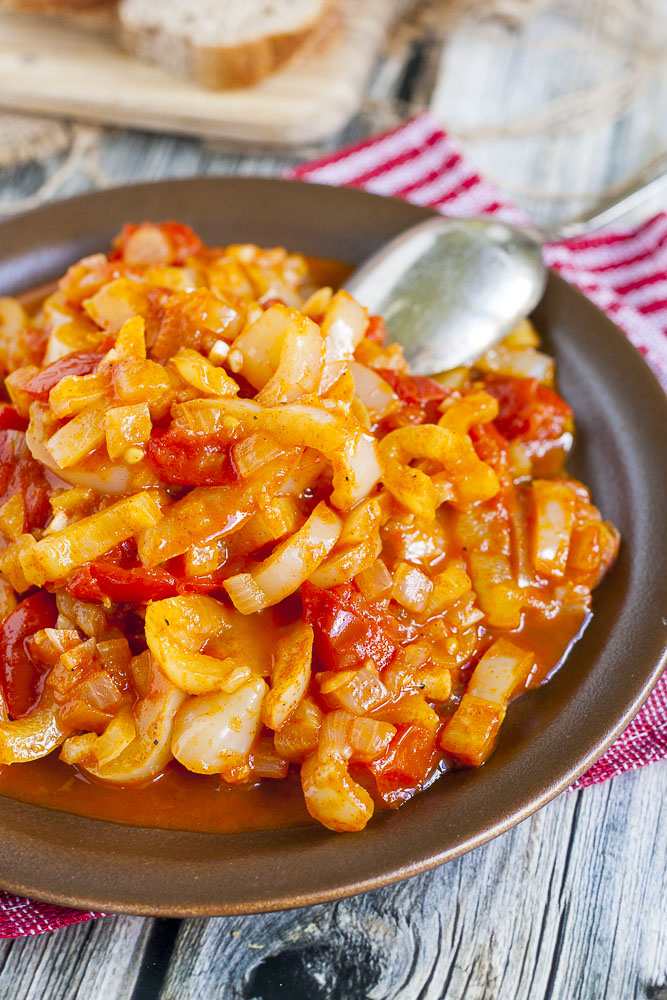How to Thicken Soup (20 Methods)
Learning how to thicken soup can add depth, body, and richness to any soup recipe. The classic way is to use flour and mix, but what if you’re allergic or looking for dairy-free alternatives? That’s where this guide to...

Learning how to thicken soup can add depth, body, and richness to any soup recipe. The classic way is to use flour and mix, but what if you’re allergic or looking for dairy-free alternatives? That’s where this guide to the 20 best ways to thicken soup comes in!

Whether you’re cooking a velvety tomato bisque or a hearty chicken noodle, the consistency of your soup can make all the difference. It can transform a thin, watery broth into a meal that’s satisfying and full-bodied.
There are many methods to thicken a soup, each with its own set of benefits. Some techniques rely on pantry staples like flour or cornstarch, while others use ingredients like potatoes, rice, or bread.
The method you choose can depend on the type of soup you’re making, the ingredients you have on hand, and your personal preference.
Understanding how to thicken soup can elevate your cooking and impress your dinner guests. With a few simple techniques, you can easily adjust the consistency of your soup to your liking.
Jump to:20 Ways to Thicken Any SoupMore ingredient guidesClassic Way to Thicken Any Soup20 Ways to Thicken Any Soup
1. Flour mixed with milk, water, or broth (The classic method)
Flour is a common ingredient used to thicken soups. It’s a versatile thickening agent that can be used in a variety of recipes. The process of using flour to thicken soup involves mixing it with a liquid before adding it to the soup. This is done to prevent the formation of lumps.
To use flour as a thickening agent, you’ll need to make a slurry. A slurry is a mixture of flour and a cold liquid such as milk, water, or broth. To make a slurry, combine equal parts flour and cold liquid in a bowl and mix until smooth.
Once your slurry is lump-free, slowly pour it into your simmer soup while stirring continuously. The heat from the soup will cook the flour, eliminating its raw flavor and thickening the soup.
It’s important to note that flour can make your soup cloudy, so if you’re aiming for a clear soup, you might want to consider other thickening options.
Also, remember to add the slurry gradually to avoid over-thickening your soup. You can always add more, but it’s difficult to thin a soup that’s been over-thickened.
2. Heavy cream or full-fat coconut milk
Adding heavy cream or full-fat coconut milk is another effective way to thicken your soup and give it a rich, creamy texture.
Both these ingredients are high in fat content, which makes them ideal for thickening purposes. They also add a delicious, creamy flavor to your soup, making it more satisfying and delicious.
If you’re looking for a dairy-free alternative, try using canned full-fat or light coconut milk. It works like a charm while imparting a coconut-y taste to your soup at the same time.
It doesn’t work with all kinds of soups due to the mild coconut flavor, but use it to thicken your curries and sauces with perfect results each time.
Our chickpea mushroom curry is a great example of a wholesome creamy curry that we absolutely love!
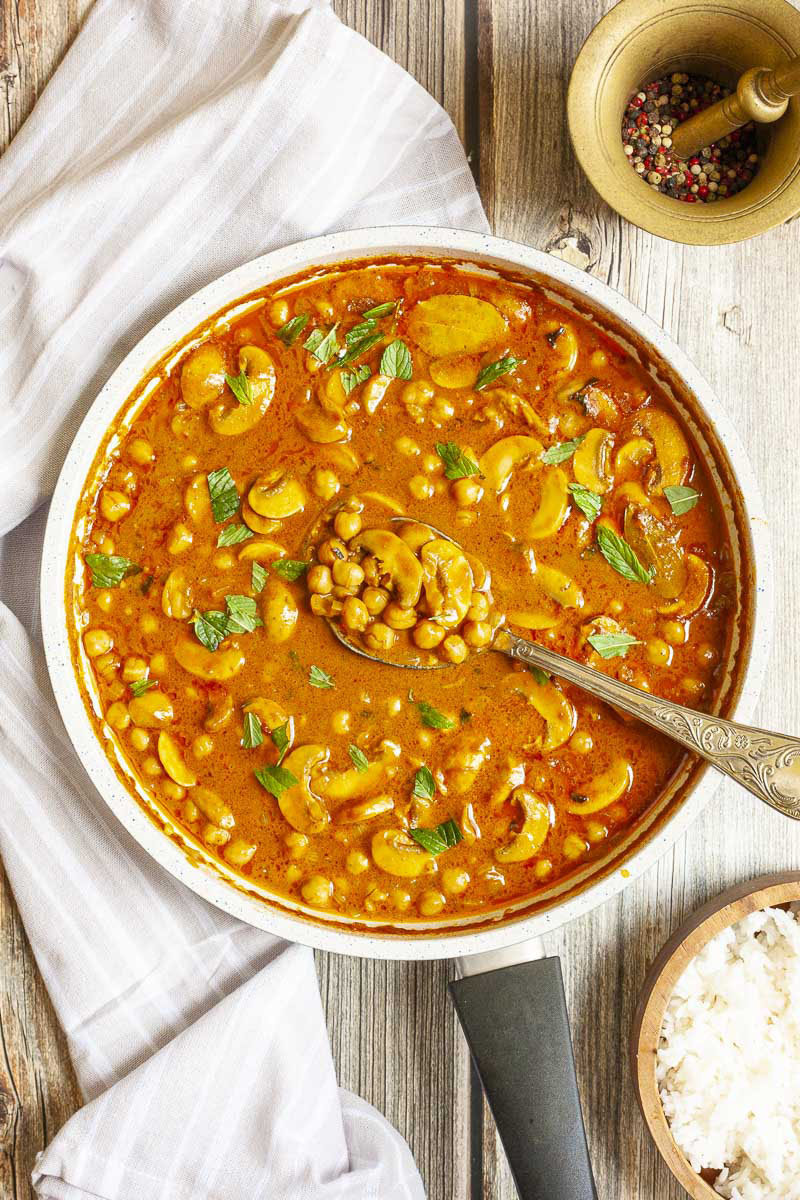
3. Sour cream, cooking cream, or plain yogurt
These dairy products are not only great for adding a creamy texture to your soup, but they also help to thicken it. They are especially useful when you’re making a soup that calls for a rich, creamy base.
To use sour cream, cooking cream, or plain yogurt to thicken your soup, you’ll want to first remove the soup from the heat. Then, take a small amount of the soup and mix it with the dairy product in a separate bowl before adding it back into the soup.
This process, known as tempering, helps to prevent the dairy product from curdling when it’s introduced to the hot soup.
Dairy-free and vegan alternatives are also ways in which you can add flavor and character to your soups.
My recipe for vegan sour cream is a great addition to every soup. I’ve used it in this cabbage soup with sausages which is a hearty, comfort food to warm you up!

4. Starch mixed with milk or broth
Cornstarch or any other starch mixed with milk (dairy or non-dairy works just the same) or veggie broth is a great natural way to thicken your soups and stews. You can use whichever you like or is readily available to you.
You will want to create a slurry with cold water in a separate bowl and add it a little at a time. Let your soup simmer for a few minutes, and you will notice that it has already taken on a thick consistency. Just like in our jackfruit stew.
You can also take a quick look at my guide for tapioca starch substitutes for a range of thickening agents that are all ideal additions to soups, desserts, and more!

5. Flours mixed with milk or broth
Flour mixed with milk is the most classic way to thicken soups. Be it all-purpose flour or gluten-free flour as well as dairy-free milk or not, simply mix it well and ensure that there are no lumps.
Pour this mix into your simmering soup and within minutes you will see it thicken.
If you use nut milk (like cashew milk) be aware that different ones have different tastes so you need to pick the ones most suitable for your soup.
If you want to use gluten-free flours, I recommend combining them with a bit of starch to make sure the thickening lasts. I usually use rice flour, but without any starch, the soup gets thin when it is reheated later.
6. Roux
Roux is a classic thickening agent used in many types of soups and sauces. It’s a mixture of equal parts fat and flour, cooked together to form a paste.
The fat used can be butter, oil, or even the drippings from meat. The flour is then added and the mixture is cooked until it reaches the desired color. The longer it’s cooked, the darker it becomes and the more flavor it imparts to the soup.
Traditionally clarified butter and flour are used for this process, but anything from vegetable oil to gluten-free flour works just as well. Simply stir the paste into your pot of soup and simmer.
My bechamel and onion gravy are two recipes in which we give you a detailed guide on making the easiest roux. And this lemony white bean soup is a delicious roux-based, zesty soup that is easy and light on the palate.
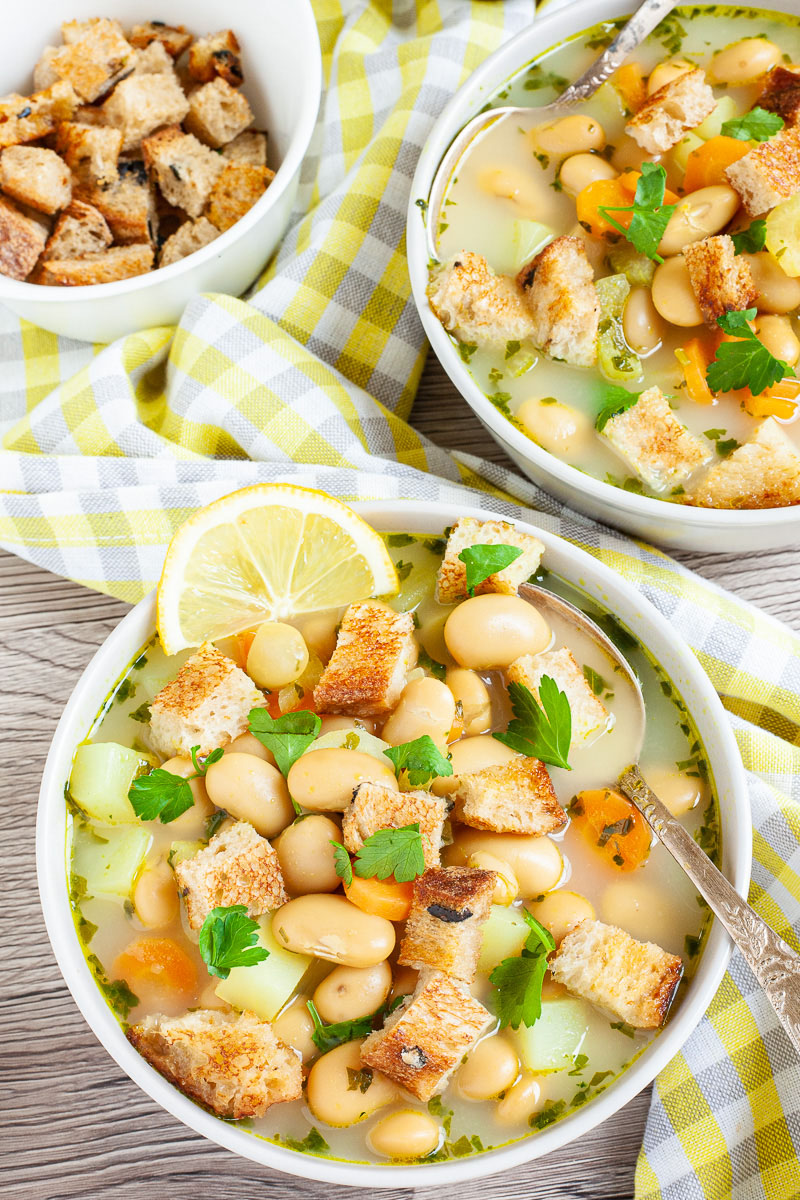
7. Gelatin, agar agar, xanthan gum, guar gum
These are all thickening agents that can be used in soups. They are all derived from natural sources and are often used in gluten-free and vegan cooking.
Gelatin is a protein derived from collagen, which is found in animal bones and skin. It is often used in soups and stews to give them a rich, velvety texture. To use gelatin to thicken soup, dissolve it in a little cold water before adding it to the hot soup. Stir well to ensure it is evenly distributed.
Agar agar is a plant-based alternative to gelatin, derived from seaweed. It has a stronger thickening power than gelatin and can be used in the same way. It is a popular choice for vegan and vegetarian dishes.
Xanthan gum and guar gum are both polysaccharides that are used as thickening agents. They are often used in gluten-free cooking as a replacement for wheat flour.
To use these gums to thicken soup, sprinkle them into the soup while stirring continuously to prevent clumping. Start with a small amount, as a little goes a long way.
8. Potatoes
Potatoes are perhaps one of the most versatile ingredients that we have in our kitchen. Comforting, familiar, and completely accessible, they open a wide avenue of unexplored recipes, tips, and tricks.
Potatoes’ starch content makes them a natural thickener and an obvious choice for use in soups.
One method is to add diced potatoes to your soup and let them cook until they are soft. The starch in the potatoes will release into the soup, naturally thickening it.
This method works well for soups that are pureéd at the end, as the potatoes will be blended into the soup, providing a smooth and creamy texture.
Potatoes are the secret to one of my favorite spinach soup which is a meal in itself and even finds mention in our ultra-creamy and smooth cauliflower soup.
And this best-ever aromatic Hokkaido pumpkin soup uses diced potatoes to achieve a mousse-like consistency that we adore.
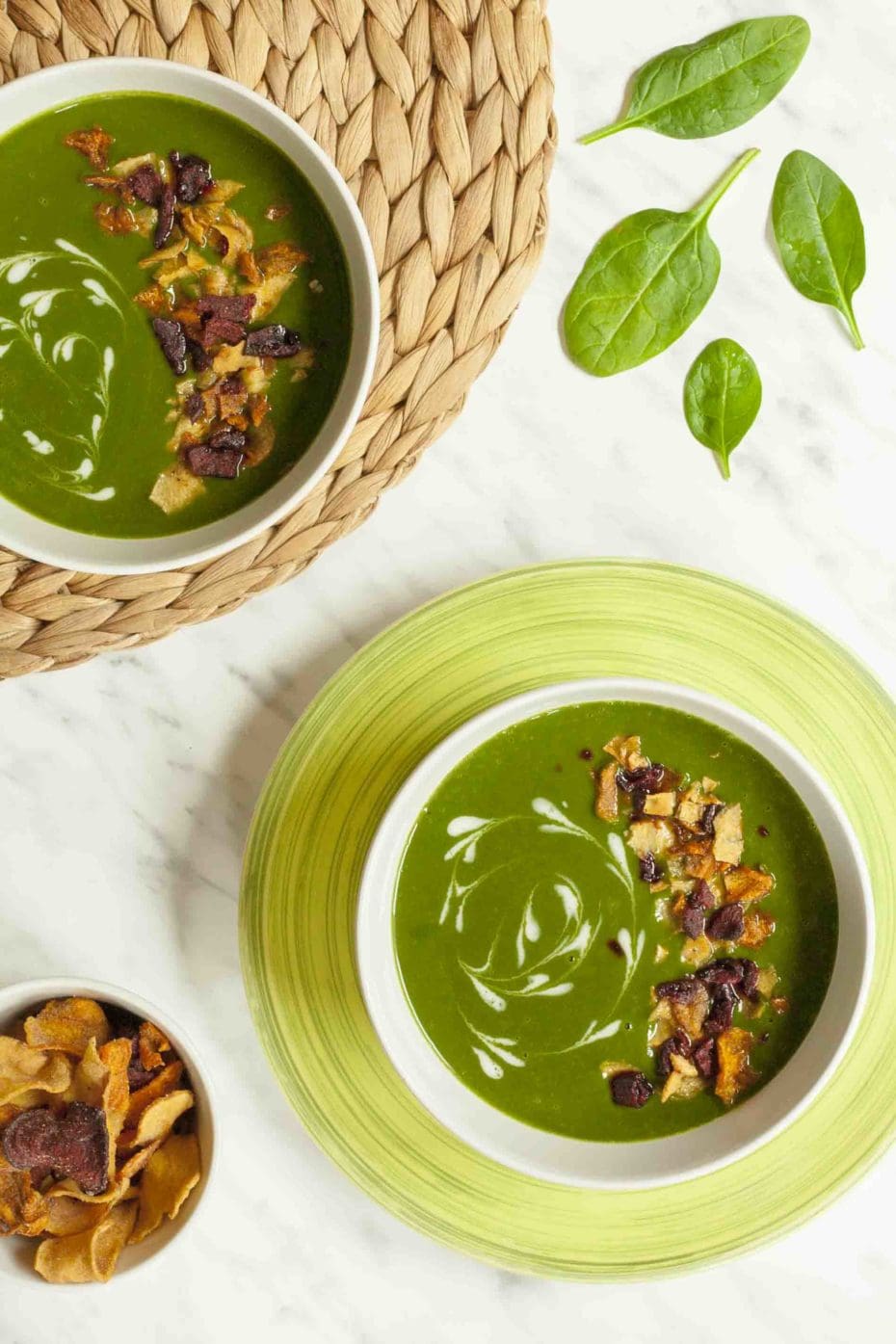 Cream of Spinach Soup
Cream of Spinach Soup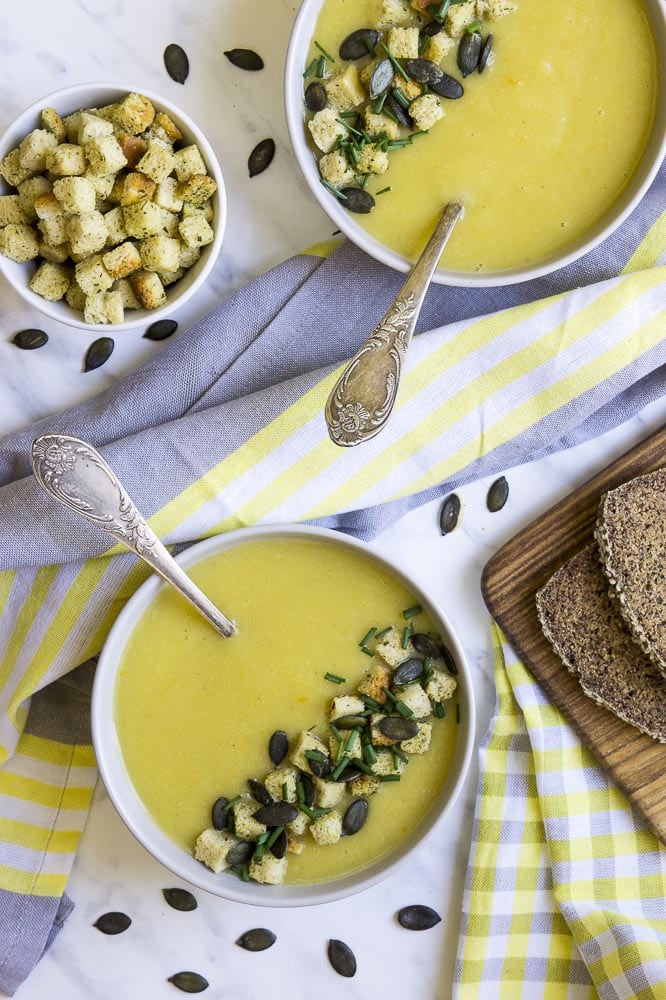 Cream of Cauliflower Soup
Cream of Cauliflower Soup9. Sweet potatoes or yams
Sweet potatoes and yams are not just for holiday side dishes. These root vegetables can also be used to thicken soups, adding a sweet and earthy flavor that complements many types of cuisine.
To use sweet potatoes or yams as a thickening agent, you’ll first need to cook them. This can be done by boiling, baking, or microwaving until they are soft and easily mashed. Once cooked, you can either blend them into a puree or mash them and add them directly to your soup.
The starch in sweet potatoes and yams helps to thicken the soup, while their natural sweetness can help balance out the flavors. This method works particularly well in soups that contain ingredients like chicken, turkey, or vegetables.
The sweet potato is the star of my ginger carrot sweet potato soup and once cooked and blended, makes for a thick bowl of velvety soup that is perfect for pairing with charred pineapple sticks.
Another recipe where the versatile vegetable shines is my peppery, thick, and nutrient-loaded roasted broccoli sweet potato soup. And this smoky sweet potato soup heroes this humble produce to make a soup that is a must-try!
 Ginger Carrot Sweet Potato Soup
Ginger Carrot Sweet Potato Soup Roasted Pumpkin Sweet Potato Soup
Roasted Pumpkin Sweet Potato Soup10. Instant potato flakes
Instant potato flakes are a quick and easy way to thicken your soup while also adding a subtle flavor that complements many types of soup. This method is particularly effective for chowders, potato soups, and other creamy soups.
To use instant potato flakes as a thickener, simply stir them into your soup towards the end of the cooking process. Start with a small amount, such as a tablespoon or two, and then add more as needed until you reach your desired consistency. The potato flakes will absorb the liquid in your soup and expand, thickening the soup without altering its flavor too much.
One of the benefits of using instant potato flakes is that they are readily available and inexpensive. They also store well, so you can keep a box in your pantry for whenever you need to thicken a soup.
However, be aware that some brands of instant potato flakes contain additives and preservatives, so check the label if you’re trying to avoid these ingredients.
11. Leftover mashed potatoes
Leftover mashed potatoes can be a great thickening agent for your soup. Not only do they add a creamy texture, but they also enhance the flavor of your soup. This method is particularly useful for potato-based soups, but it can work well with other types as well.
To use leftover mashed potatoes to thicken your soup, simply add them to your soup while it’s simmering, stirring continuously. The amount you add will depend on how thick you want your soup to be.
Start with a small amount, let it simmer for a few minutes, and then check the consistency. If you want it thicker, add more mashed potatoes.
Remember, mashed potatoes already have flavor, so they will change the overall flavor of your soup. If you’re using this method, you might want to adjust your seasonings accordingly.
I love this mashed potatoes with celery root. It is an interesting take on the classic, and can be easily mixed into a range of soups and broths for a new recipe that will have your friends asking for more!
12. Pasta
Pasta is another excellent ingredient to thicken your soup. Not only does it add body to the soup, but it also enhances the flavor and makes the dish more filling.
To use pasta as a thickening agent, you have a couple of options. You can either cook the pasta directly in the soup, allowing the starches to release into the broth and thicken it, or you can blend cooked pasta and add it to the soup.
If you decide to cook the pasta in the soup, keep in mind that it will absorb a lot of the soup’s liquid, so you may need to add more broth or water to maintain the desired consistency.
On the other hand, if you choose to blend the pasta, cook it until it’s soft, then blend it with a bit of the soup’s broth until it forms a smooth paste. Gradually stir this paste into your soup, and let it simmer until it reaches your preferred thickness.
If you ever made minestrone soup, you might have realized that even if you cook the pasta separately, the next day the soup is thicker. It also happens to leftover pasta dishes. If you store them with the sauce on, the pasta might get extra mushy and the sauce “disappears”.
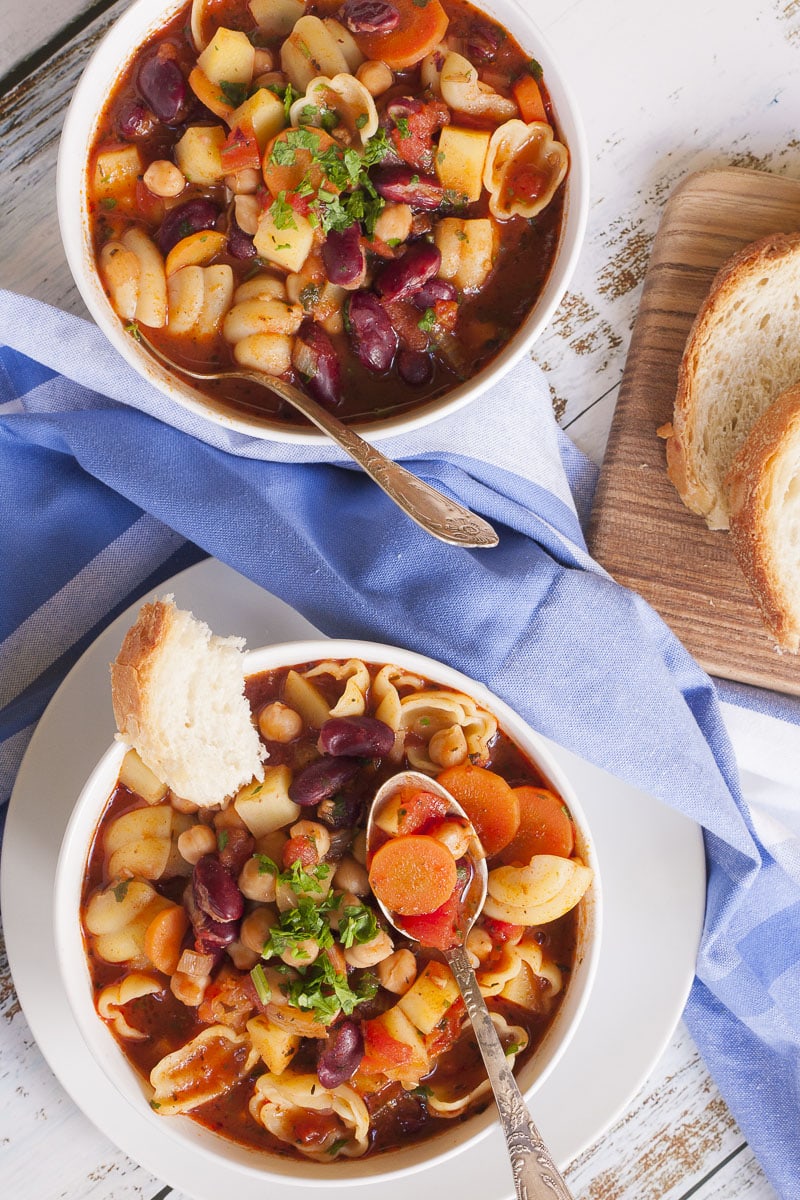
13. Rice, millet, and other grains
Rice and most other grains are all carbs, which are typically starchy. Their high starch content makes them a good thickening agent that can be effortlessly used in soups and more.
For rice and most other grains, the process is the same as that of using pasta. Cooking the grains down with the soup will help in releasing them and making the soup thick.
But what do you do with the leftover rice? Just let it cook further with the soup and blend it in. If you’re thinking of using rolled oats, make sure you soak them before cooking them down.
In the below picture, you can see my vegan bean chili with millet. I used millet to make it more hearty and filling as well as to have some chunky texture in place of ground beef. But millet also helped to make this chili thick.
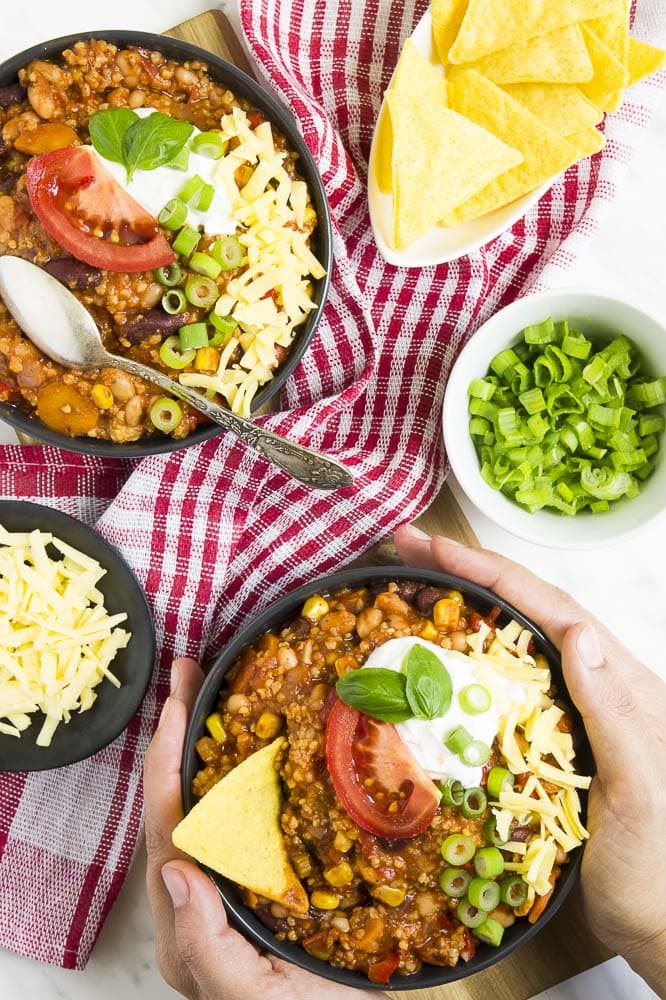
14. Pureed vegetables
Pureéd vegetables are a natural and nutritious way to thicken your soup. Not only do they add depth and flavor, but they also contribute to the overall healthiness of your dish.
All you need to do is to take out some from your soup and blend them until completely fine, without any bits and pieces. Add this thick blend back into the pot with the rest of the veggies and soup and let it simmer. That’s it! Your soup will be ready in no time and with the least effort possible.
My cream of mushroom soup uses a technique similar which I highly recommend.
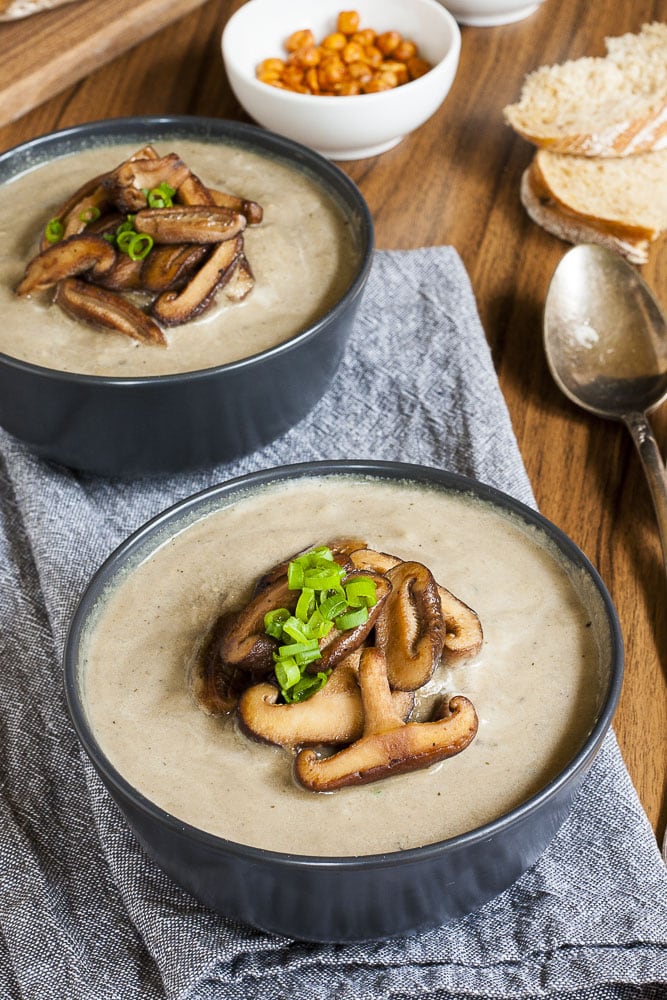
15. Nuts and seeds
Nuts and seeds are not only a great source of protein and healthy fats, but they can also be used to thicken soups. This method is particularly useful in vegan or vegetarian recipes, where other thickening agents like cream or meat-based broths are not used.
To use nuts and seeds as a thickening agent, you will first need to grind them into a fine powder. This can be done using a food processor or a high-powered blender. Once the nuts or seeds are ground, they can be added directly to the soup.
Almonds, cashews, and sunflower seeds are all great choices for this method. They not only add thickness to the soup but also contribute to its overall flavor. For instance, almonds can add a subtle sweetness, while sunflower seeds can add a slight nutty flavor.
Cashew cream can also be used and is a common substitute for heavy cream or other dairy and has a mild taste that can also be masked with vegetables. I have used it in my vegan corn chowder which is oil-free and widely liked.

16. Legumes
Legumes, such as lentils, chickpeas, and beans, can be an excellent choice for thickening your soup and adding a healthy dose of protein and fiber. This method works best with soups that are meant to have a creamy consistency, like lentil or split pea soup.
To thicken your soup with legumes, you’ll first need to cook them until they’re soft. If you’re using canned legumes, you can add them directly to the soup. If you’re using dried legumes, you’ll need to soak them overnight and then cook them before adding to the soup.
Once the legumes are soft, use an immersion blender or a standard blender to puree them. Be sure to leave some legumes whole for texture. The puree will mix with the broth and thicken the soup. If you want a thicker soup, simply puree more legumes.
This vegetable pasta sauce is a superb mix of fresh veggies and chickpeas that together make a delicious, thick sauce.

17. Stale bread or breadcrumbs
Stale bread, believe it or not, is also used to thicken soups. The method is simple and applies to any bread.
You can tear it into smaller pieces to make things easier or go ahead as is. That is how gazpacho soups are thickened actually. They are raw soups and as no heat is involved none of the above options is suitable here.
Soak the bread in the soup for a few seconds or until soft. Take the slice of bread or breadcrumbs out and blend it into a paste. Add this paste to the soup and let it all simmer for a few minutes. It is always preferred to use mild bread so that its flavor can be masked.
But if you want a fresh twist, you can also choose to use flavored bread. The choice is entirely yours.
If you eat gluten-free, be sure to use gluten-free panko or any of the other gluten-free breadcrumbs substitutes.
18. Soft silken tofu
Soft silken tofu is a versatile ingredient that can be used to thicken soups, adding an incredible texture and a subtle, creamy flavor. It’s a great option for those following a vegan or vegetarian diet, as it’s plant-based and packed with protein.
To use soft silken tofu as a thickening agent, you’ll first need to blend it until it reaches a smooth consistency. This can be done using a blender or food processor. Once blended, you can add the tofu to your soup and stir it in until it’s fully incorporated.
The amount of tofu you’ll need will depend on the thickness you desire for your soup. Start with a small amount, such as a quarter of a block, and add more as needed. Remember, it’s always easier to add more tofu than to try and remove it once it’s been mixed in.
One of the benefits of using soft silken tofu is that it doesn’t alter the flavor of your soup significantly.
19. Shredded cheese
Shredded cheese is another excellent ingredient to thicken your soup. Not only does it add a creamy texture, but it also imparts a rich and savory flavor to your soup. Cheese like cheddar, mozzarella, and parmesan are perfect for this purpose.
To use shredded cheese as a thickener, you first need to cook your soup until all the ingredients are well-cooked. Then, gradually add the shredded cheese to the soup while stirring continuously. Make sure the soup is on low heat to prevent the cheese from clumping together and sticking to the bottom of the pot.
Remember, different types of cheese have different melting points and flavors. Therefore, the type of cheese you choose will significantly affect the thickness and flavor of your soup. For example, cheddar cheese will give your soup a thicker consistency and a sharper flavor than mozzarella cheese.
Keep in mind that adding too much cheese can make your soup overly thick and heavy. Therefore, it’s best to add the cheese gradually and check the consistency of the soup as you go.
If you find that the soup is still not as thick as you’d like, you can add more cheese or use another thickening method in conjunction with the cheese.
20. Eggs
Eggs are a versatile ingredient that can be used in a variety of ways to thicken soup. They not only add a rich and creamy texture, but also enhance the flavor of the soup. Here are a few ways you can use eggs to thicken your soup:
Tempering: This method involves gradually adding hot soup to beaten eggs to raise their temperature slowly, preventing them from curdling when they’re added back into the soup. This technique is commonly used in Greek Avgolemono soup, which is thickened with a mixture of eggs and lemon juice.
Egg Yolks: Egg yolks are a great thickening agent due to their high protein content. You can whisk them into a small amount of broth before adding the mixture back into the soup. This will result in a creamy, velvety texture.
Egg Drop Method: This technique is used in Chinese cuisine to make egg drop soup. Simply beat an egg in a bowl and slowly pour it into the simmering soup while stirring. The egg will cook instantly, forming silky ribbons that thicken the soup.
More ingredient guides
We have been writing more and more ingredient guides. We explain in detail how to prepare them, how to cook with them, and what to serve with them. Here are some of the other articles you might be interested in:
Classic Way to Thicken Any Soup
While there are 20 ways to thicken any soup listed in this article, this method is the most popular and well-known of them all.
Prep Time 5 minutes
Total Time 5 minutes
Course Soup
Servings 1 portion
Calories 55kcal
Ingredients
EXCLUSIVE 5-ingredient recipes for busy home cooks that are ready in 15 minutes!Check out our Express Vegan Cookbook!
Instructions
1 portion of slurry will thicken a soup which is approx. 6 cups / 50 fl. oz / 1.5 litres.
Take a separate small bowl and mix 1 cup of milk, water, or broth with 2 Tablespoons of flour to create a slurry.
If you use any dairy products, you need to temper them to avoid clumping. To do that you need to take a bit out of the hot soup and add to it. You need to take as much as to bring the temperature of the slurry closer to the temperature of the soup.
When it is whisked properly, add it into the soup.
Bring it to a boil until it reaches the desired thickness. It’s easy, convenient, and handy.
Notes
Please note that the ratio of how to thicken a soup with flour largely depends on what kind of vegetables are in the soup. If you have a lot of starchy vegetables like potatoes than your soup may be too thick in the end. If that happens, don’t worry. Making something thinner is always easier than making something thicker.
Nutrition
Nutrition Facts
Classic Way to Thicken Any Soup
Amount Per Serving (1 portion)
Calories 55 Calories from Fat 1
% Daily Value*
Fat 0.1g0%
Saturated Fat 0.02g0%
Polyunsaturated Fat 0.1g
Monounsaturated Fat 0.01g
Sodium 12mg1%
Potassium 16mg0%
Carbohydrates 11g4%
Fiber 0.4g2%
Sugar 0.04g0%
Protein 2g4%
Calcium 9mg1%
Iron 1mg6%
* Percent Daily Values are based on a 2000 calorie diet.

 Troov
Troov 











